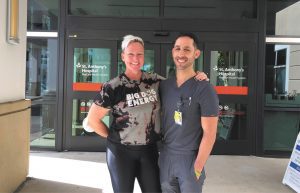
life-saving procedure last fall when she came to the hospital suffering a massive heart attack.
Lara Warn instantly stands out in the crowd as she arrives for a weekly cycling class near downtown St. Petersburg. But it’s not just from the muscular frame of a natural athlete, the burst of platinum blond hair atop her otherwise close-cropped head, or the warm, mega-watt smile she flashes to fellow riders.
It’s the mere fact that Warn is here at all – spinning a dramatic and inspiring story beyond her comfort zone, while spreading a message she hopes will save lives as part of her new journey.
The path has led the normally private 42-year-old, an absolute picture of health, to publicly share an account of a massive heart attack that would have killed her last fall if not for her own gut instincts and the expertise of the fast-acting emergency room and cardiac teams at St. Anthony’s Hospital.
What’s more, this unexpected turn in the road motivated Warn to step into the spotlight on April 30 in a way she never imagined: She participated in the Sprint-distance race of the St. Anthony’s Triathlon, which marked its 40th year in April. She competed in her first triathlon as a way to honor the medical staff and hospital that gave her a new chance at life.
“I want to take my power back,” said Warn, the owner of Pup Active, a canine-themed online apparel company. “I want to compete in a race sponsored by the hospital that saved me. And I want to help people, because if I had heard a story like mine before it happened, I would have gone for treatment immediately.”
As her surname might suggest, she hopes to warn others that the onset of heart attacks don’t necessarily mirror Hollywood depictions, such as comedian Redd Foxx’s chest-clasping bit on the 1970s sitcom Sanford & Son. And for women, Warn has since learned that the signs of a heart attack can be particularly hard to recognize.
‘We think you’re having a heart attack’
The morning of Oct. 24 began harmlessly enough at a local gym. Warn sensed only that she felt a bit off – with no inkling of the total blockage of the largest heart vessel, the left anterior descending artery. As she counted weight reps, the seconds counted down to a potentially fatal cardiac event known as the Widow Maker.
“I had just started my normal workout and was about three or four minutes in, and not even breathing heavily or sweating,” she recalls. “All I felt was a very slight pinch or burning in my chest. It didn’t hurt but felt weird. At first, I thought, ‘Oh, I had a salad before working out – it must be that.’”
Warn decided to return home, take a cold shower and lie down. Had she fallen asleep, she now knows, she never would have awakened. “My intuition was, ‘Just go to the doctor and see,’ ” she remembers.
She dressed quickly and drove to nearby St. Anthony’s. When she arrived at the emergency center, she explained, “My chest feels a little weird, and I’m having a harder time breathing as time goes by.”
In seconds, Warn was fitted with EKG sensors, while a group of people hovered over her. A nurse held her hand, and calmly relayed the news: “We think you’re having a heart attack.”
No way was that possible, Warn thought, but now the nurse was asking her whom they should call. That’s when it suddenly hit her. Warn asked the nurse, “Am I going to die?” She would never forget her reassuring reply. “I don’t think so – not today.”
Warn’s thoughts blurred as she was raced down a hallway on a gurney to the cardiac catheterization lab. There, Jason Levine, MD, a cardiologist, and his team inserted a microscopic tube through her wrist and saw no blood flow in her artery. The team inflated a tiny balloon to clear the full obstruction and inserted two stents.
When she awakened, a St. Anthony’s team member asked if she knew what happened. Warn answered shakily: “I think I had a heart attack? He looked me in the eyes and said, ‘You had a massive heart attack. You’re very lucky to be alive.’ ”
Heart-to-Heart Talk
She was only in the hospital some 40 hours. Within a month, she was eager to resume physical activity – understandable for a former multi-sport star who grew up in Japan where her mother taught school. Samantha Radigan, a St. Anthony’s physician assistant, urged her to take it slow as they gauged her recovery in follow-up appointments. But one day, Warn had an idea to share with her: She wanted to compete in the St. Anthony’s Sprint Triathlon, which consists of a 750-meter swim, a 20K bike ride and a 5K run.
“I said, ‘I know we’ve had me pulling back a little bit, but I wonder if I can do this and start training,’ ” Warn recalls. “Samantha looked at the chart, and looked at me, and then she said, ‘Let it rip!’ ”
With that, she began a weekly regimen of running 2-3 miles, swimming 750 meters and taking three-to-five classes at a local cycling gym. “I don’t care if I finish last,” she says, “I’m going to complete the race.”
Heed the Warning Signs
Earlier this year, Warn had the opportunity to meet Dr. Levine for the first time since the day of her heart attack. The reunion, which also included Radigan, was tinged with tears and laughter.
“Time is heart muscle, so everyone jumped into action,” Dr. Levine said. “The sooner we can identify the blockage and open it up, the sooner the heart will get the oxygen and blood it desperately needs.”
“When you have a really great cath lab team,” Radigan added, “everything in that moment works like a symphony.”
The medical team was surprised to see a heart attack victim in such excellent condition. Yet later, findings of an elevated cholesterol panel indicated some concern for family history and genetics. Dr. Levine sees a trend of heart attack victims getting younger, and he underscores that women often present different symptoms than men.
“Obviously, the No. 1 symptom for men and women is chest pain,” he says. “But 40 percent of women who come in with heart attacks don’t even have chest pain.”
The takeaway: If something feels amiss and is a concern, have it checked out. “We see people here all the time and they feel dumb if it’s not cardiac but heartburn,” Radigan says. “But I tell all of those people you should never feel silly.”
Fast forward to St. Anthony’s Triathlon Weekend, which became a run-bike-run event because of inclement weather. But Warn didn’t mind. As she approached the finish line on that wind-whipped Sunday morning, she made a most surprising move in the race of her life. She stopped.
Amid the flood of emotions washing over her in that moment, Warn paused to hug a small group of close friends who had cheered her on and held up cut-out likenesses of her face and signs, including one that read, “Lara makes my (heart) skip a beat.”
“I feel such a sense of gratitude,” Warn said minutes after crossing the line. “I’m just choked up. All my friends were there. I’m alive. I get to be here – and I finished.”
St. Anthony’s Hospital
 Central Florida Health and Wellness Magazine Health and Wellness Articles of the Villages
Central Florida Health and Wellness Magazine Health and Wellness Articles of the Villages
